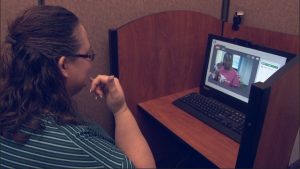- Slug: BC-CNS-911 texts. About 630 words.
- Video story and photo available (thumbnail and caption below)
By BLAKELY McHUGH
Cronkite News
LAKE HAVASU CITY – It’s dark. You’re hiding in your closet. Someone just broke in and you’re alone. You can’t call police because you don’t want the intruder to know where you are. You need to send a text.
Your house is on fire house and you’re trapped. Smoke is filling your lungs. It’s hard for you to speak. You can’t call the fire department. You need to send a text.
You’ve just been in an accident and you’re injured. You’re deaf or hard of hearing and there’s no WiFi. Your sign-language service doesn’t work. You need to send a text.
Law enforcement and safety experts say emergencies should spur the launch of a system that allows people to text 911 instead of calling.
For most people, contacting the police means dialing 911, telling the dispatcher the nature of the emergency and its location. People with speech or hearing disabilities have to go through a third party to contact police.
“For deaf and hard of hearing people and speech disabled folks, they always have that fear of not having the access to emergency services, and getting the help that they need right now,” said Beca Bailey, deaf specialist for the Arizona Commission for the Deaf and Hard of Hearing.
A deaf or hard of hearing person contacts police with a videophone through a Video Relay Service that puts the caller in contact with an operator who knows American sign language. The operator then contacts police and relays information back and forth between the caller and police.
Bailey said the system is inefficient because it delays help in an emergency. She said that it took her nearly three hours to get help when she was in a car accident.
“Videophones are a good resource at home, but this world is very mobile right now, and so we use our mobile phones,” Bailey said. “And sometimes WiFi isn’t capable of allowing us to make those videophone calls, but immediate services could be done through text.”
Lake Havasu City implemented text-to-911 service in April and has gotten positive feedback people with hearing disabilities and other residents.
It’s the only city in Arizona to have text-to-911 capabilities, Bailey and Gray said. Most states have the texting system in at least one city and only nine states are completely without it. Bailey said Maricopa County is considering implementing a system.
“It’s important in a lot of different situations. We’ve had a lot of positive feedback from the deaf, hard of hearing and speech impaired community,” Sgt. Tom Gray, a police spokesman, said. “This gives them direct and immediate access to our 911 services, but it can also be used in the event of an emergency when someone can’t make a voice call.”
The system works by simply texting 911. A dispatcher who receives the message responds with a preset message asking the person’s location, the nature of specific emergency and asking if it’s safe to make a voice call.
Gray advises to “call if you can, text if you can’t.”
Text-to-911:
- A text or data plan is required to place a text to 911.
- Location accuracy varies by carrier.
- Text-to-911 is not available on roaming.
- Text-to-911 services will not be available when a wireless carrier can’t determine the person’s location.
- If text-to-911 isn’t available or the message cannot be delivered, the phone will get a bounce back message saying to make a voice call to 911 for help.
- Only the English language is available on the text service. Language interpretation services are not available.
- Text messages can take longer to send or receive and may get out of order.
- Text-to-911 cannot be sent as a group message.
Source: Lake Havasu Police Department
^__=
